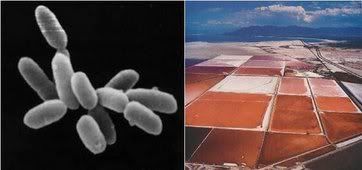Scientists predict extremophile cell's dynamics at genome scale - relevance for biofuels

The new study marks the first time researchers have accurately predicted a cell's dynamics at the genome scale, for most of the thousands of components in the cell. The findings, which are based on a study of Halobacterium salinarum, a free-living microbe that lives in hyper-extreme environments (and a candidate for any potential life on Mars), appear in the latest issue of the journal Cell.
The study's lead authors are New York University Assistant Biology Professor Richard Bonneau, who holds appointments at NYU's Center for Genomics & Systems Biology and the university's Courant Institute for Mathematical Sciences, and Nitin Baliga of the Institute for Systems Biology in Seattle, WA. The study also included researchers at the University of Maryland, Vanderbilt University, and the University of Washington.
Systems biology
The researchers focused on a little studied 'extremophile' that can survive high salt, radiation, and other stresses that would be deadly to most other organisms. By focusing on such an organism the researchers were able to show definitively that they could understand and model the circuit controlling the cell directly from experiments designed to measure all genes in the genome simultaneously. These are called systems-biology experiments.
This scholarship is part of a new scientific field, systems biology, which examines how genes influence each other via extremely large networks of interaction and how these networks respond to stimuli, adapting over time to new environments and cell states. The field has blossomed over the past 10 years, spurred by successful mapping of genomic systems.
Predicting cell dynamics
By a combination of experimental and algorithmic advances studies in this area have shown that scientific knowledge can go from genome to a functional and dynamical draft-model of the whole organism in a relatively short time. Important previous studies in this area identified cell components (genome sequencing) and how cell components are connected. But the study in Cell went beyond previous scholarship and accurately modeled how Halobacterium, an important organism in high-salt environments such as the Dead Sea or Utah's Great Salt Lake, functioned over time and responded to changing environmental conditions. The researchers were, for the first time, able to predict how over 80 percent of the total genome (several thousand genes) responded to stimuli over time, dynamically rearranging the cell's makeup to meet environmental stresses:
 energy :: sustainability :: biomass :: bioenergy :: biofuels :: microbe :: extremophile :: microbiology :: genomics :: systems biology :: biosynthesis ::
energy :: sustainability :: biomass :: bioenergy :: biofuels :: microbe :: extremophile :: microbiology :: genomics :: systems biology :: biosynthesis :: This organism is amazingly versatile and tolerates lots of different extreme environmental stressesIt does this by making decisions and dynamically changing the levels of genes and proteins; if it makes incorrect decisions it dies. Our model shows how these decisions get made, how the bug responds. This is also a good model to explain how, in general, cells make stable decisions as they move through time scales. If you want to understand how cells respond to their environments, the model offers a clearer window than previously existed for this domain of life. - Richard Bonneau, Assistant Biology Professor, New York UniversityThe collaboration between Baliga's and Bonneau's research groups represents a type of partnership becoming more essential to biological and biomedical research: biologists and computer scientists teaming up to design experiments and analysis that synergize to decipher living systems, resulting in ever more complex and accurate models of the cell:
The result is more comprehensive, reaching genome-scale levels, more accurate, and more relevant to biologists and biomedical researchers hoping to understand the whole system
Bonneau says that by understanding how biological systems function, researchers can then turn their attention to engineering the biosynthesis of biofuels and pharmaceuticals.
We are now gearing up to try this sort of analysis on several other organisms. In addition, because this study examined the dynamics of a key environmental microbe it offers a window into understanding life in extreme environments, in some cases created by human activities, such as the concentration of pollution by evaporation or high salt marine environments. - Richard BonneauThe study was sponsored by the National Science Foundation and the U.S. Department of Energy.
Image: Halobacterium salinarum, which can be found in such extreme environments like Utah's Great Salt Lake. Credit: Richard Hubmacher/MicrobeWiki.
References:
Richard Bonneau et al., "A Predictive Model for Transcriptional Control of Physiology in a Free Living Cell", Cell, Vol 131, 1354-1365, 28 December 2007.
Eurekalert: Study maps life in extreme environments - December 28, 2007.
Biopact: Investigating life in extreme environments may yield applications in the bioeconomy - July 05, 2007
 --------------
--------------
 PetroChina Co Ltd, the country's largest oil and gas producer, plans to invest 800 million yuan to build an ethanol plant in Nanchong, in the southwestern province of Sichuan, its parent China National Petroleum Corp said. The ethanol plant has a designed annual capacity of 100,000 tons.
PetroChina Co Ltd, the country's largest oil and gas producer, plans to invest 800 million yuan to build an ethanol plant in Nanchong, in the southwestern province of Sichuan, its parent China National Petroleum Corp said. The ethanol plant has a designed annual capacity of 100,000 tons.








0 Comments:
Post a Comment
Links to this post:
Create a Link
<< Home